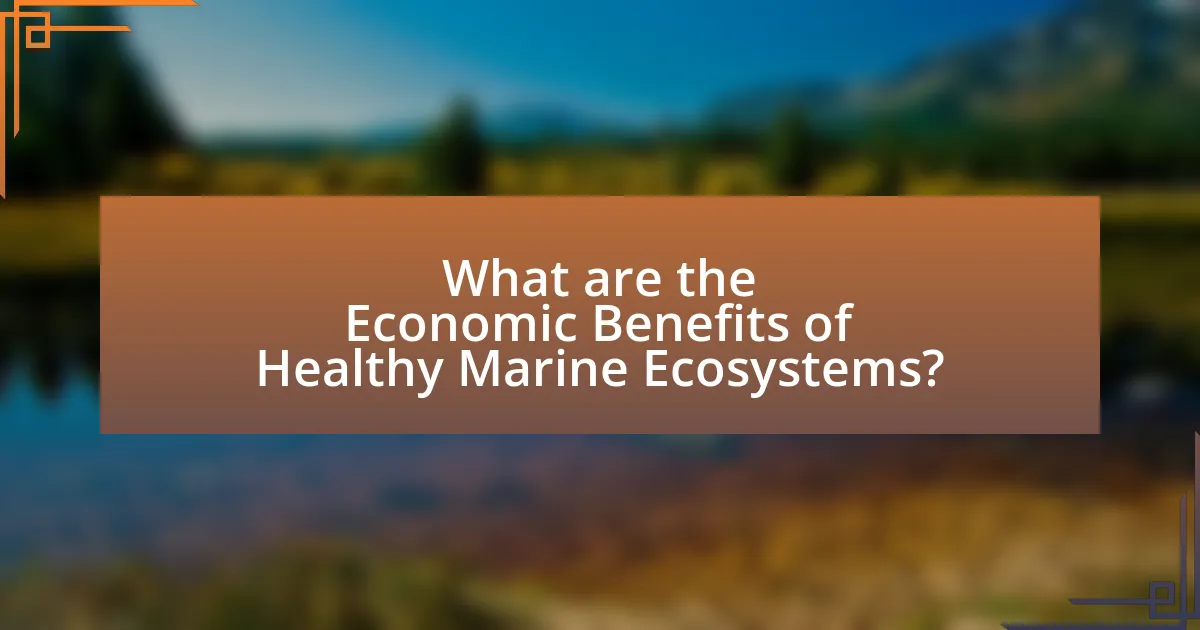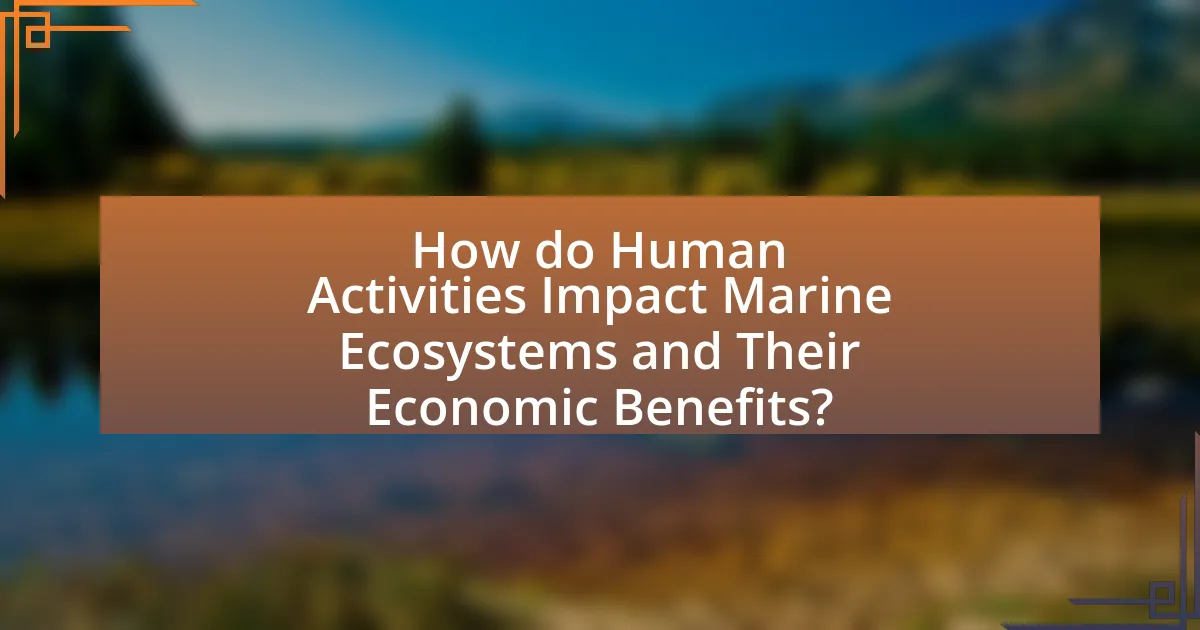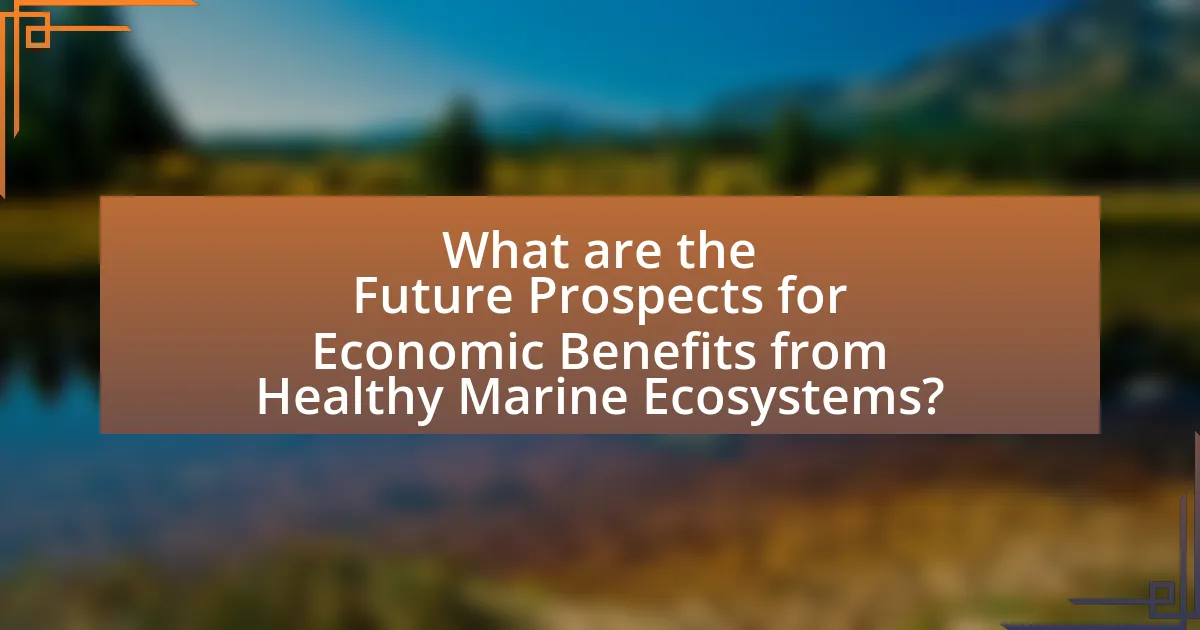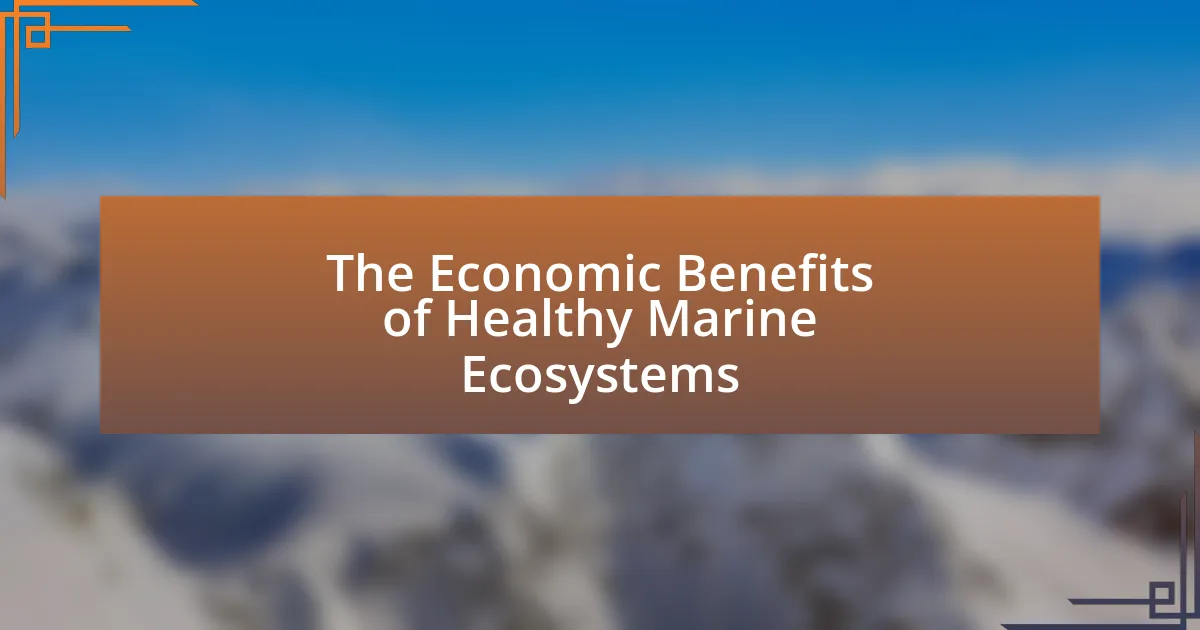Healthy marine ecosystems are vital for economic prosperity, contributing significantly to fisheries, tourism, and coastal protection. Sustainable fisheries alone generate approximately $100 billion annually, while marine tourism accounts for over $400 billion, highlighting the economic potential of vibrant marine environments. These ecosystems also provide essential services such as natural storm barriers, reducing disaster recovery costs and protecting infrastructure. The article explores the various economic benefits derived from healthy marine ecosystems, the impact of human activities on their health, and the importance of sustainable practices and community engagement in preserving these critical resources for future economic stability.

What are the Economic Benefits of Healthy Marine Ecosystems?
Healthy marine ecosystems provide significant economic benefits, including enhanced fisheries, tourism opportunities, and coastal protection. For instance, sustainable fisheries contribute approximately $100 billion annually to the global economy, supporting millions of jobs and food security. Additionally, marine tourism, which generates over $400 billion each year, relies on vibrant ecosystems to attract visitors for activities like diving and whale watching. Furthermore, healthy coastal ecosystems, such as mangroves and coral reefs, act as natural barriers against storms, reducing damage costs and protecting infrastructure, which can save communities billions in disaster recovery expenses. These economic advantages underscore the importance of maintaining and restoring marine ecosystems for long-term sustainability and economic resilience.
How do healthy marine ecosystems contribute to local economies?
Healthy marine ecosystems significantly contribute to local economies by supporting fisheries, tourism, and coastal protection. Fisheries rely on diverse marine habitats, which provide breeding and feeding grounds for fish, leading to sustainable catches that support local livelihoods. For instance, the global fishing industry generates approximately $362 billion annually, with many coastal communities depending on these resources for income and employment.
Additionally, healthy marine environments attract tourists, boosting local businesses such as hotels, restaurants, and recreational services. In the Caribbean, for example, coral reefs draw millions of visitors each year, contributing over $3 billion to the regional economy. Furthermore, intact marine ecosystems offer natural barriers against storms and erosion, reducing infrastructure damage and associated costs. Studies indicate that investing in coastal ecosystem restoration can yield economic returns of up to $30 for every dollar spent, highlighting the financial benefits of maintaining healthy marine environments.
What specific economic activities are supported by healthy marine ecosystems?
Healthy marine ecosystems support specific economic activities such as commercial fishing, tourism, and aquaculture. Commercial fishing relies on diverse and abundant fish populations, which are sustained by healthy habitats like coral reefs and mangroves. For instance, the global fishing industry is valued at approximately $362 billion annually, highlighting its economic significance. Tourism, particularly in coastal areas, benefits from vibrant marine life and ecosystems, attracting millions of visitors each year; in 2019, marine tourism generated over $100 billion globally. Aquaculture, or fish farming, also thrives in healthy marine environments, providing a sustainable source of seafood and contributing to food security. These activities demonstrate the direct economic benefits derived from maintaining healthy marine ecosystems.
How do marine ecosystems influence tourism and recreation industries?
Marine ecosystems significantly influence tourism and recreation industries by providing diverse attractions such as coral reefs, beaches, and marine wildlife, which draw millions of visitors annually. For instance, the Great Barrier Reef in Australia generates approximately $6 billion in tourism revenue each year, supporting local economies and creating jobs. Healthy marine environments enhance recreational activities like snorkeling, diving, and fishing, which are vital for tourism. Additionally, the presence of vibrant marine life increases the appeal of destinations, leading to higher visitor numbers and extended stays. Studies indicate that areas with well-preserved marine ecosystems experience a 20-30% increase in tourism-related income compared to those with degraded environments.
Why are healthy marine ecosystems important for fisheries?
Healthy marine ecosystems are crucial for fisheries because they provide essential habitats and resources that support fish populations. These ecosystems, such as coral reefs, mangroves, and seagrasses, serve as breeding and nursery grounds for various fish species, which enhances biodiversity and ensures sustainable fish stocks. Research indicates that areas with healthy marine habitats can yield up to 50% more fish biomass compared to degraded environments, directly impacting the productivity and profitability of fisheries. Additionally, healthy ecosystems contribute to nutrient cycling and water quality, further supporting fish health and growth, which is vital for both commercial and subsistence fishing industries.
How do healthy ecosystems affect fish populations and biodiversity?
Healthy ecosystems significantly enhance fish populations and biodiversity by providing essential habitats, food sources, and breeding grounds. For instance, coral reefs and mangroves serve as critical nurseries for many fish species, promoting their growth and survival. Research indicates that areas with intact ecosystems can support up to 50% more fish biomass compared to degraded environments, demonstrating a direct correlation between ecosystem health and fish abundance. Additionally, diverse ecosystems contribute to genetic diversity among fish populations, which is vital for resilience against diseases and environmental changes. Studies have shown that biodiversity within marine ecosystems leads to more stable and productive fisheries, ultimately benefiting local economies reliant on fishing.
What role do marine ecosystems play in sustainable fishing practices?
Marine ecosystems are crucial for sustainable fishing practices as they provide habitat, breeding grounds, and food sources for fish populations. Healthy marine ecosystems, such as coral reefs and mangroves, support biodiversity, which enhances the resilience of fish stocks against overfishing and environmental changes. For instance, studies show that areas with intact marine habitats can yield up to 50% more fish than degraded areas, demonstrating the direct correlation between ecosystem health and fishery productivity. Additionally, marine ecosystems help maintain water quality and nutrient cycling, which are essential for sustaining fish populations and ensuring long-term fishing viability.
What are the indirect economic benefits of healthy marine ecosystems?
Healthy marine ecosystems provide significant indirect economic benefits, including enhanced coastal protection, improved water quality, and increased tourism opportunities. These ecosystems, such as mangroves and coral reefs, act as natural barriers against storms and erosion, reducing the costs associated with property damage and disaster recovery. For instance, studies have shown that coastal wetlands can reduce flood damage by up to 50%, saving communities millions in potential losses. Additionally, healthy marine environments contribute to better water quality, which supports fisheries and recreational activities, further boosting local economies. The tourism sector also thrives on vibrant marine ecosystems, with coral reefs alone attracting millions of divers and snorkelers annually, generating substantial revenue for coastal communities.
How do marine ecosystems contribute to climate regulation and coastal protection?
Marine ecosystems contribute to climate regulation and coastal protection by sequestering carbon dioxide and reducing the impact of storm surges. These ecosystems, such as mangroves, salt marshes, and seagrasses, act as carbon sinks, absorbing significant amounts of CO2 from the atmosphere; for instance, mangroves can sequester up to four times more carbon per hectare than tropical forests. Additionally, they provide natural barriers against coastal erosion and flooding, mitigating the effects of extreme weather events. Studies show that coastal habitats can reduce wave energy by up to 66%, thereby protecting shorelines and human settlements from damage.
What is the economic value of ecosystem services provided by marine environments?
The economic value of ecosystem services provided by marine environments is estimated to be between $3 trillion and $6 trillion annually. These services include fisheries, coastal protection, carbon sequestration, and tourism, which contribute significantly to global economies. For instance, the global fisheries sector alone is valued at approximately $362 billion per year, while coastal ecosystems like mangroves and coral reefs provide essential protection against storm surges, reducing potential damages worth billions. Additionally, marine ecosystems support tourism, generating over $400 billion annually, highlighting their critical role in economic sustainability and resilience.

How do Human Activities Impact Marine Ecosystems and Their Economic Benefits?
Human activities significantly impact marine ecosystems, leading to both ecological degradation and economic consequences. Activities such as overfishing, pollution, and coastal development disrupt marine biodiversity, resulting in the decline of fish populations and the degradation of habitats like coral reefs. For instance, overfishing has led to a 90% decline in some fish stocks globally, which directly affects the livelihoods of communities dependent on fishing. Additionally, pollution from plastics and chemicals can harm marine life and reduce the quality of seafood, further impacting economic benefits derived from healthy marine ecosystems. The loss of biodiversity and ecosystem services, such as tourism and fisheries, can result in economic losses estimated at billions of dollars annually, highlighting the critical link between human activities, marine health, and economic viability.
What are the main threats to marine ecosystems?
The main threats to marine ecosystems include overfishing, pollution, habitat destruction, climate change, and invasive species. Overfishing depletes fish populations, disrupting food webs and leading to ecosystem imbalances. Pollution, particularly from plastics and chemicals, contaminates marine life and habitats, causing health issues for species and humans alike. Habitat destruction, such as coral reef degradation and mangrove deforestation, reduces biodiversity and the resilience of marine environments. Climate change results in ocean warming and acidification, which adversely affect marine species and ecosystems. Invasive species can outcompete native species, leading to declines in biodiversity and altering ecosystem functions. These threats collectively undermine the health of marine ecosystems, which are vital for economic benefits such as fisheries, tourism, and coastal protection.
How does pollution affect marine life and economic activities?
Pollution significantly harms marine life and economic activities by disrupting ecosystems and diminishing biodiversity. Marine organisms, such as fish and coral, suffer from toxic substances like heavy metals and plastics, leading to health issues, reproductive failures, and increased mortality rates. For instance, a study published in the journal “Marine Pollution Bulletin” found that microplastics can cause physical harm and toxicological effects in marine species, which in turn affects the food chain and ecosystem stability.
Economically, the decline in marine biodiversity directly impacts industries such as fishing and tourism. The World Bank estimates that overfishing and pollution could cost the global economy up to $83 billion annually by 2030 due to reduced fish stocks and degraded marine habitats. Healthy marine ecosystems are crucial for sustaining fisheries and attracting tourists, making pollution a significant threat to both environmental health and economic viability.
What impact does overfishing have on marine ecosystems and local economies?
Overfishing severely disrupts marine ecosystems and negatively affects local economies. The depletion of fish populations leads to imbalances in marine food webs, resulting in the decline of species that rely on those fish for survival, such as predators and scavengers. For instance, studies indicate that overfishing can cause a 50% reduction in fish populations, which in turn affects biodiversity and ecosystem health.
In terms of local economies, overfishing diminishes the availability of fish, which is a primary source of income and food for many coastal communities. According to the Food and Agriculture Organization, overfishing has led to a loss of approximately $83 billion annually in potential economic benefits from fisheries. This economic decline impacts jobs, food security, and the overall livelihoods of those dependent on fishing industries.
How can sustainable practices enhance the economic benefits of marine ecosystems?
Sustainable practices enhance the economic benefits of marine ecosystems by promoting biodiversity, which leads to increased fish stocks and healthier habitats. For instance, implementing sustainable fishing techniques can prevent overfishing, allowing fish populations to recover and thrive, which in turn supports local fisheries and boosts income for communities reliant on fishing. According to a study by the World Bank, sustainable fisheries can generate up to $83 billion annually if managed properly, highlighting the significant economic potential of healthy marine ecosystems. Additionally, practices such as marine protected areas (MPAs) can enhance ecosystem resilience, leading to improved tourism opportunities and recreational activities, further contributing to local economies.
What strategies can be implemented to protect marine ecosystems?
To protect marine ecosystems, implementing strategies such as establishing marine protected areas (MPAs), regulating fishing practices, and reducing pollution is essential. Marine protected areas, which cover approximately 7.6% of the world’s oceans, help conserve biodiversity and restore fish populations by limiting human activities in designated zones. Regulating fishing practices, including enforcing sustainable catch limits and banning destructive fishing methods, ensures that fish stocks remain viable and ecosystems are not disrupted. Additionally, reducing pollution through stricter regulations on land runoff and plastic waste can significantly improve water quality and habitat health, as studies show that pollution is a leading cause of marine ecosystem degradation. These strategies collectively contribute to the resilience and sustainability of marine environments, ultimately supporting the economic benefits derived from healthy marine ecosystems.
How do conservation efforts translate into economic gains?
Conservation efforts translate into economic gains by enhancing ecosystem services that support industries such as tourism, fisheries, and coastal protection. For instance, healthy marine ecosystems, like coral reefs, attract millions of tourists annually, generating significant revenue; the global reef tourism market is valued at approximately $36 billion. Additionally, sustainable fisheries management, a key aspect of conservation, can lead to increased fish stocks, which boosts local economies reliant on fishing. Studies show that for every dollar invested in marine conservation, there is a return of up to $20 in economic benefits, demonstrating the financial viability of these efforts.

What are the Future Prospects for Economic Benefits from Healthy Marine Ecosystems?
Healthy marine ecosystems are projected to yield significant economic benefits in the future, primarily through sustainable fisheries, tourism, and coastal protection. Sustainable fisheries can enhance food security and generate income, with the global fish market valued at approximately $362 billion in 2020, indicating a robust economic potential. Additionally, marine tourism, which contributes over $400 billion annually, is expected to grow as more people seek eco-friendly travel experiences. Furthermore, healthy marine ecosystems provide natural coastal protection, reducing the economic costs associated with storm damage and erosion, which can amount to billions of dollars annually. These prospects underscore the critical importance of preserving marine health for future economic stability and growth.
How can innovation and technology improve marine ecosystem management?
Innovation and technology can significantly improve marine ecosystem management by enabling more effective monitoring, data collection, and analysis. Advanced technologies such as satellite imagery, drones, and underwater sensors allow for real-time tracking of marine health indicators, including water quality and biodiversity levels. For instance, the use of remote sensing technology has been shown to enhance the detection of harmful algal blooms, which can devastate marine life and local economies. Additionally, data analytics and machine learning can process vast amounts of ecological data, leading to better-informed decision-making and resource allocation. These technological advancements not only streamline management practices but also promote sustainable fishing and conservation efforts, ultimately supporting the economic benefits derived from healthy marine ecosystems.
What role does research play in enhancing the economic value of marine ecosystems?
Research plays a crucial role in enhancing the economic value of marine ecosystems by providing data that informs sustainable management practices and conservation efforts. For instance, studies have shown that healthy marine ecosystems, such as coral reefs and mangroves, can significantly boost local economies through tourism and fisheries. According to a report by the World Resources Institute, coral reefs contribute approximately $375 billion annually to global economies through tourism, fisheries, and coastal protection. Furthermore, research helps identify the economic benefits of ecosystem services, such as carbon sequestration and water filtration, which can be quantified and integrated into policy-making. This evidence-based approach ensures that marine resources are utilized sustainably, ultimately increasing their long-term economic value.
How can community engagement and education contribute to sustainable marine economies?
Community engagement and education are essential for fostering sustainable marine economies by promoting awareness and responsible practices among local populations. Engaged communities are more likely to participate in conservation efforts, leading to healthier marine ecosystems that support fisheries and tourism. For instance, educational programs that inform fishers about sustainable practices can reduce overfishing, thereby ensuring long-term fish stocks and economic stability. Research indicates that regions with strong community involvement in marine management see a 30% increase in fish populations, which directly benefits local economies reliant on fishing. Thus, effective community engagement and education create a foundation for sustainable practices that enhance both ecological health and economic resilience.
What best practices can be adopted to maximize economic benefits from marine ecosystems?
To maximize economic benefits from marine ecosystems, best practices include sustainable fisheries management, habitat restoration, and the promotion of marine tourism. Sustainable fisheries management ensures that fish populations remain healthy and can continue to provide food and income, as evidenced by the fact that well-managed fisheries can yield up to 30% more catch than overfished ones. Habitat restoration, such as the replanting of mangroves and seagrasses, enhances biodiversity and supports fisheries, with studies showing that restored habitats can increase fish populations by 50%. Promoting marine tourism, particularly eco-tourism, generates revenue while encouraging conservation, as seen in regions where marine parks have led to a 20% increase in local economies. These practices collectively enhance the resilience and productivity of marine ecosystems, leading to sustained economic benefits.
How can stakeholders collaborate to ensure the health of marine ecosystems?
Stakeholders can collaborate to ensure the health of marine ecosystems by establishing partnerships that promote sustainable practices and shared management of resources. Collaborative efforts can include joint research initiatives, where scientists and industry representatives work together to monitor ecosystem health and assess the impacts of human activities. For instance, the Ocean Conservancy and various fishing communities have successfully implemented programs that balance economic interests with conservation efforts, leading to healthier fish stocks and improved biodiversity. Additionally, stakeholders can engage in policy advocacy to influence regulations that protect marine environments, as seen in the establishment of marine protected areas, which have been shown to enhance ecosystem resilience and provide long-term economic benefits through tourism and fisheries.
What are the key takeaways for businesses and policymakers regarding marine ecosystem health?
Businesses and policymakers must prioritize the protection and restoration of marine ecosystems to ensure sustainable economic benefits. Healthy marine ecosystems provide essential services such as fisheries, tourism, and coastal protection, which contribute significantly to local and global economies. For instance, the World Bank estimates that sustainable fisheries can generate up to $83 billion annually, highlighting the economic potential of maintaining marine biodiversity. Additionally, policymakers should implement regulations that mitigate pollution and overfishing, as these practices threaten marine health and, consequently, economic stability. By investing in marine conservation, businesses can enhance their long-term profitability while supporting ecosystem resilience, ultimately benefiting both the economy and the environment.
